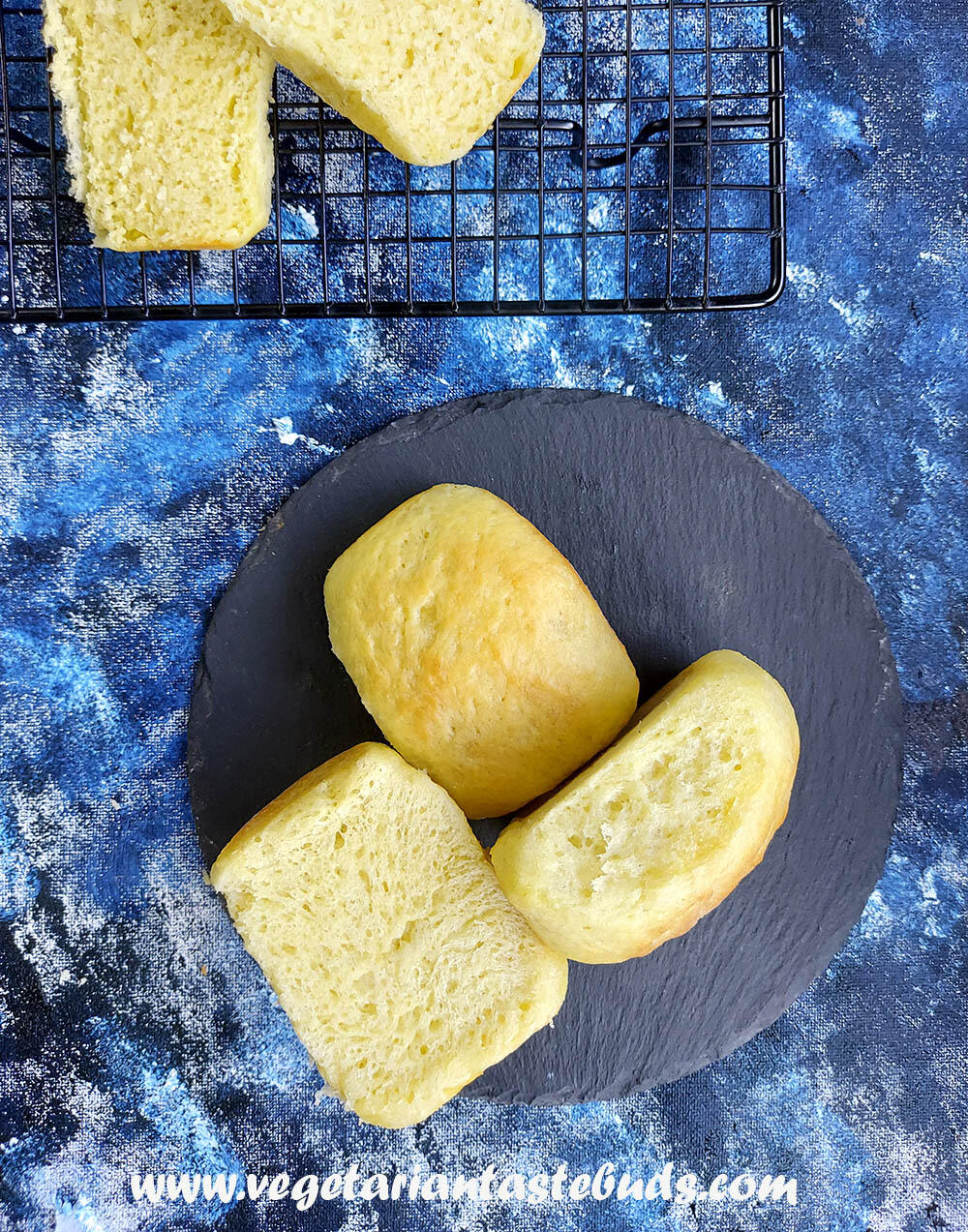
Sooji Ladi Pav Recipe with step by step photos | eggless semolina buns recipe
Homemade pav are always best compared to the store bought ones. We have already shared a tried and tested recipe of Ladi Pav using maida. You can read the detailed recipe along with 10 tips to make perfect ladi pav. The tips will also help you to prepare these ladi pav with perfection. These ladi pavs are prepared using 100% semolina or sooji.
You can also refer to our detailed post on Tips to bake perfect breads.
Ingredients
We have used semolina flour in this recipe. Semolina flour is also known as Durum Wheat. But if you don’t find semolina flour, then you can use fine sooji (or rava) or Chirotti Rava.
Still if you are not able to find that as well, then you can grind regular coarse sooji in mixer grinder and use.
Milk Powder
Milk powder can be sweetened or unsweetened. Check yours before adding to the recipe. We have used unsweetened milk powder. If you are using sweetened milk powder, then quantity of sugar required will be little less in the recipe.
Milk powder gives a nice texture and flavour to breads. If you don’t have milk powder, then for 1 tbsp milk powder, replace ¼ cup milk instead of water.
Yeast
We have used Instant Yeast in this recipe.
Conversion of Instant Yeast & Active Dry Yeast
Instant Yeast v/s Active dry Yeast :
1 teaspoon instant yeast = 1 ¼ teaspoon active dry yeast
1 teaspoon active dry yeast = ¾ teaspoon instant yeast
Salt
Do not add salt while fermenting yeast. Also, in this recipe we are adding salt at a later stage. Addition of salt at a later stage helps to achieve window pane much faster.
Sugar
Sugar acts as a food for yeast and helps in yeast fermentation process. So, if you want you can reduce the quantity of sugar in this recipe, but do add little bit sugar to activate the yeast.
Oil
You can use any odourless oil. Even olive oil works fine.
Water
Temperature of water should be lukewarm while adding yeast. Water should not be too hot, it should be just warm. To test, dip your finger in it, if you are comfortable then temperature is ok. If you feel it is hot then let it cool down a bit. If the water is too hot, it will kill the yeast and yeast mixture will not turn frothy. If it is too cold, it will take long time to ferment.
Tips & Variations to make the BEST Eggless Sooji Ladi Pav
- Use raw sooji/rava. Do not use roasted suji.
- You can use the same recipe for making Semolina Sandwich Bread.
- Gradually add warm water while kneading the dough. You will need about ¼ cup water at this stage. Sooji will absorb water while kneading, so you can add remaining quantity of water at that stage.
How to know when the dough is ready for proofing
Dough prepared from semolina will take a bit more time as compared to maida/wheat flour dough. Knead the dough for 12-15 minutes, but do not over-knead. Once ready, dough will become elastic – you will be able to easily stretch the dough and dough will not stick to the surface in which you are kneading the dough.
After about 5 minutes of kneading, start adding 1 tablespoon oil gradually and keep kneading. Along with oil you can also sprinkle water while kneading. As we mentioned earlier, sooji will absorb excess water and dough will turn dry while kneading. So you have you keep adding oil & water while kneading dough. Knead until you get a smooth dough.
Why are we adding salt at a later stage?
This method is as the ‘delayed salt’ method. Addition of salt at a later stage helps to achieve window pane much faster. So when you are kneading the bread dough with hands, it becomes difficult and tiresome to keep on kneading till we reach to our window pane stage. Addition of salt at a later stage allows natural, or biological, development of a part of the amino acids in gluten, called cystein, to occur, which can’t happen in the presence of salt. This method is much helpful when we are kneading the dough with hands.
Step by Step Recipe
For yeast fermentation
- In a small bowl, combine ¼ cup warm water, yeast and sugar. Water should not be too hot, it should be just warm. To test, dip your finger in it, if you are comfortable then temperature is ok. If you feel it is hot then let it cool down a bit.
- Stir well till no lumps remain. If you see that there are lumps of yeast in the mixture, heat the mixture for a few seconds. Cover and set aside for about 10 minutes or till the mixture is frothy. If the mixture does not turn frothy, discard this and start again.
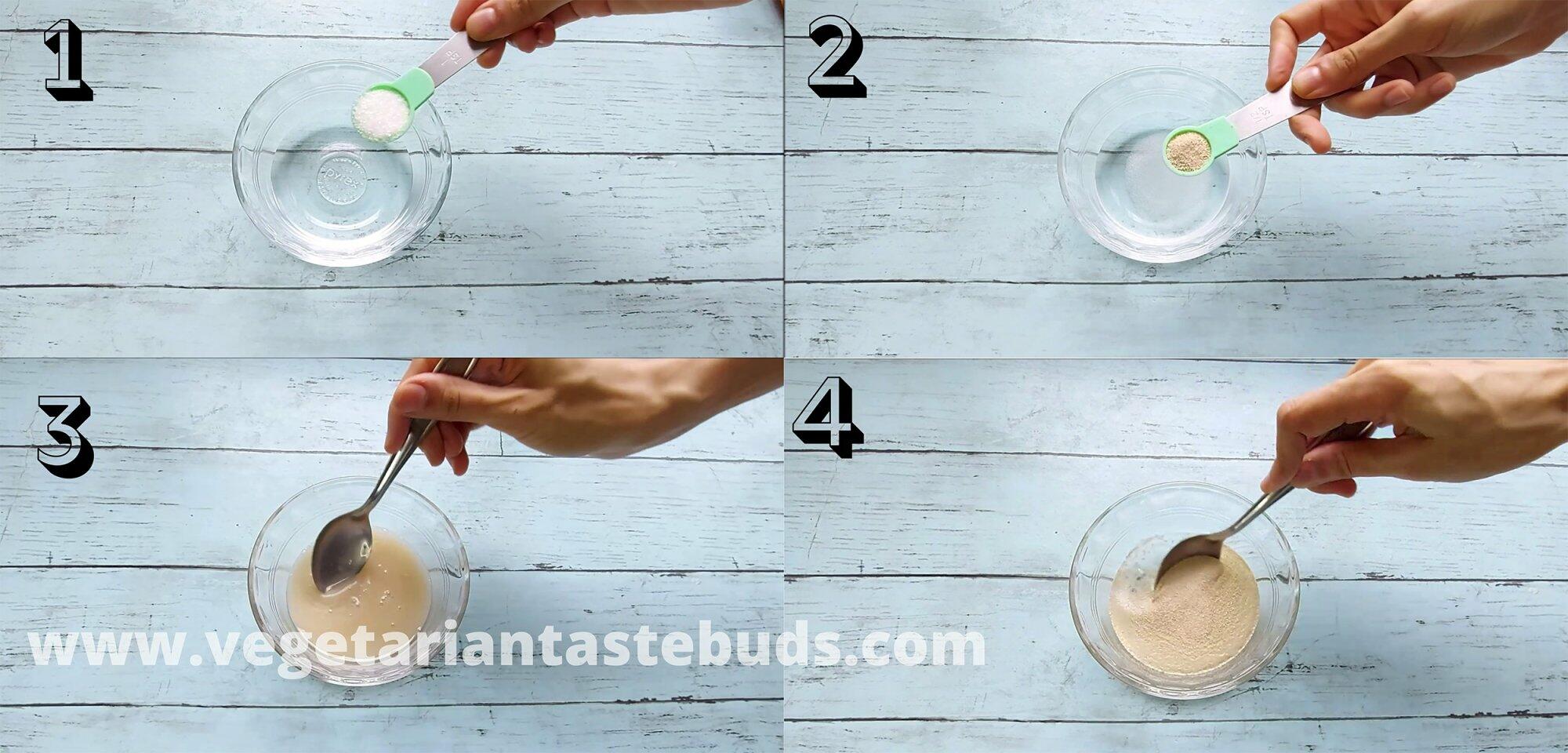
For the dough
- In a big wide bowl, combine semolina flour (fine sooji) and milk powder.
- Now add frothy yeast mixture and mix.
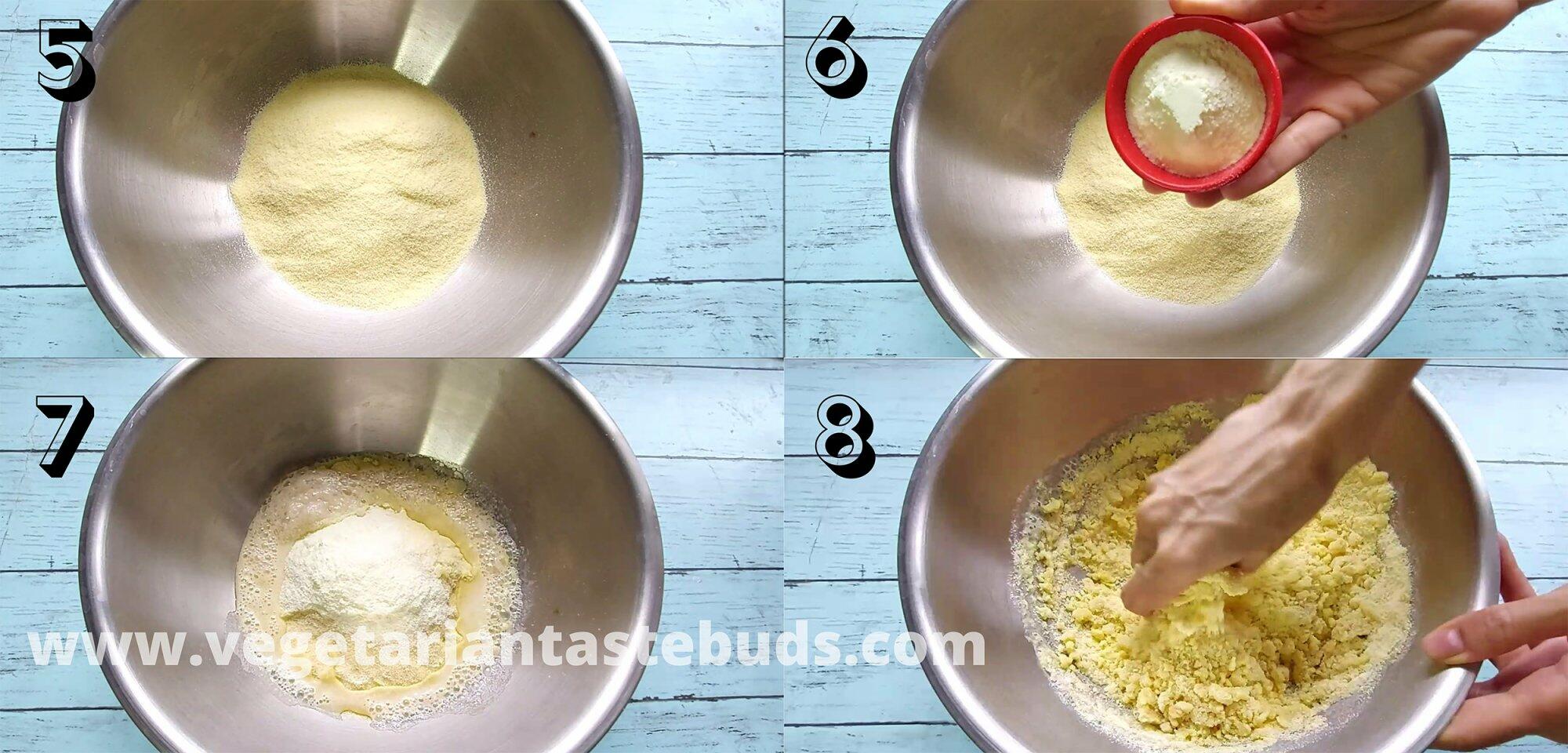
- Gradually add warm water and combine everything together. You will need about ¼ cup water at this stage. Sooji will absorb water while kneading, so you can add remaining quantity of water at that stage.
- Once everything is combined well, add 1 tablespoon oil and knead till oil is absorbed into the dough.
- Now take this dough on a flat surface and knead well for a total of 12-15 minutes. After about 5 minutes of kneading, start adding 1 tablespoon oil gradually and keep kneading. Along with oil you can also gradually sprinkle water while kneading. As we mentioned earlier, sooji will absorb excess water and dough will turn dry while kneading. So you have you keep adding oil & water while kneading dough. Knead until you get a smooth dough. Dough prepared from semolina will take a bit more time as compared to maida/wheat flour dough.
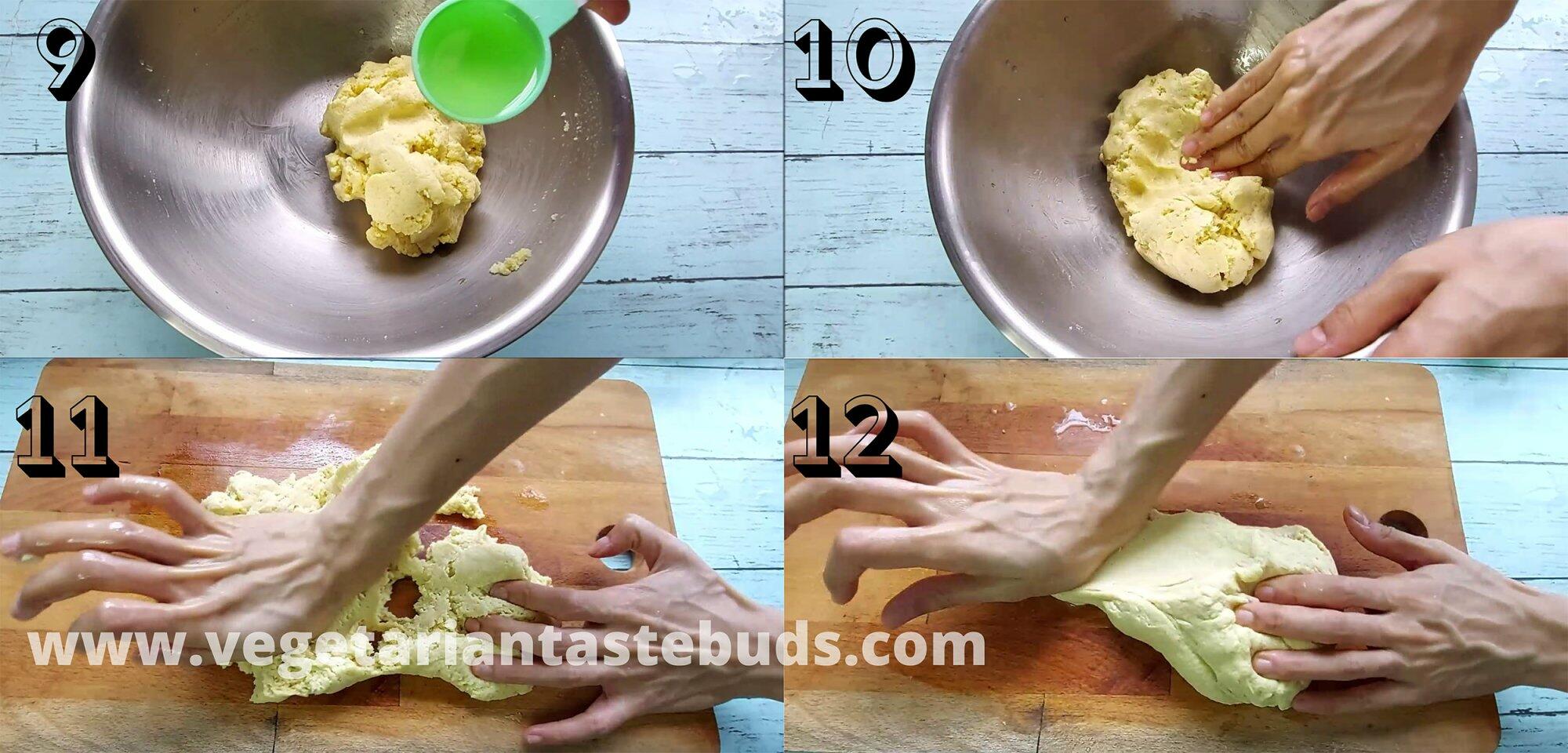
- How to know when the dough is ready :
Knead the dough for 12-15 minutes, but do not over-knead. Once ready, dough will become elastic – you will be able to easily stretch the dough, it will pass the window pane test and dough will not stick to the surface in which you are kneading the dough. - Now at this stage we will add salt. Spread the dough and add salt and sprinkle few drops of oil/water over it and mix. Now knead the dough for 2-3 minutes till salt is mixed well with the dough.
- Once you are done with kneading, wash your hands so the dough doesn’t stick more. Texture of the dough should be smooth and not sticky. Then put few drops of oil on the dough and shape the dough into a smooth ball. Take a bowl, grease it with some oil and place the dough in the bowl. Coat dough with oil, cover the dough with a kitchen towel or plate. Keep aside to rise for 1 – 1.5 hours or till dough doubles in size.
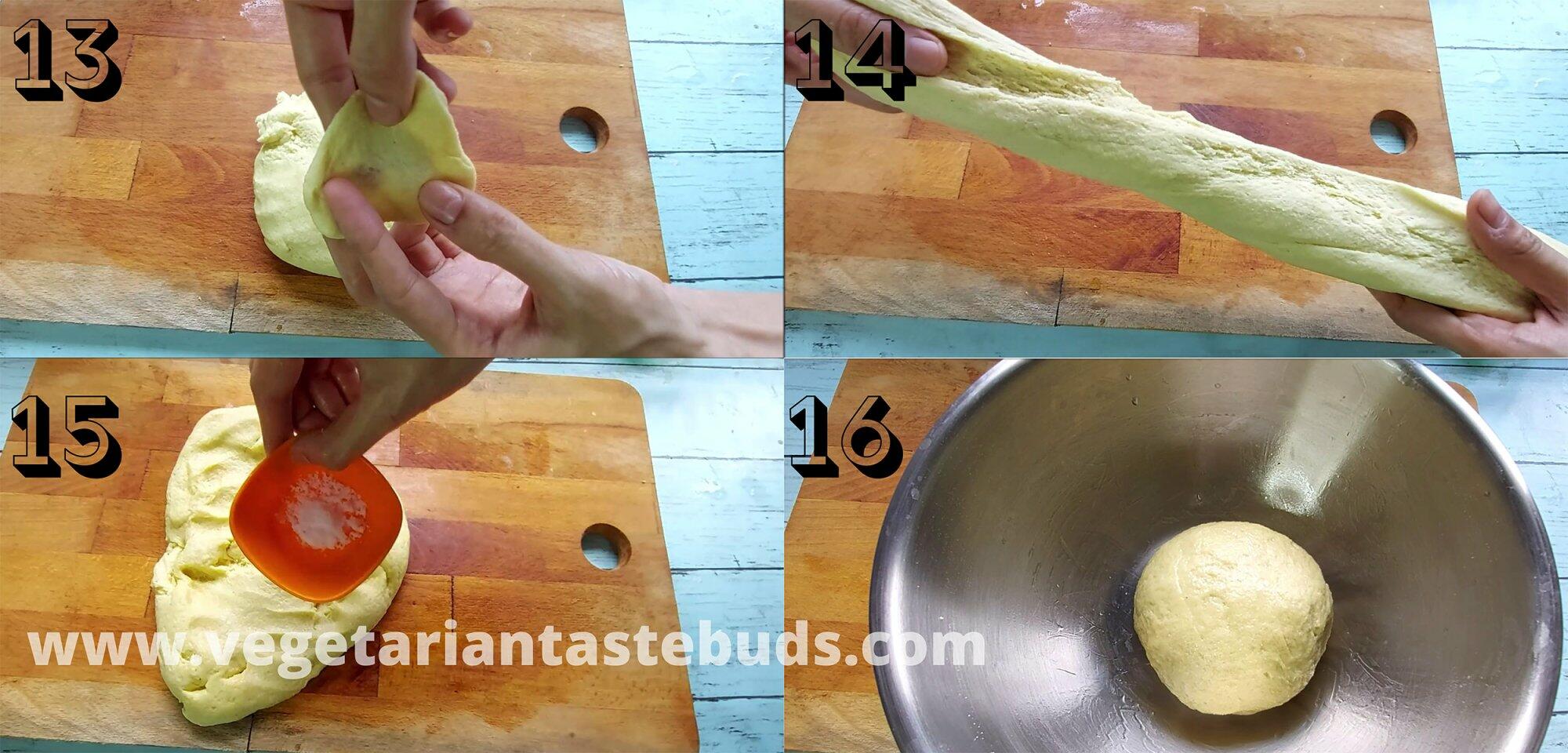
- Grease baking tin with generous amount of oil. This much quantity of ingredients will yield 6 pav buns. These buns will be of the size that you usually get in market for vada pav or pav bhaji. If you prefer small size buns, then you can make 7-8 pavs. We have used 9 inch bread tin to make 4 pav and remaining 2 pavs we have prepared in muffin moulds.
- Once the dough doubles in size, punch the dough and knead lightly for about a minute. Spread oil on a flat surface and place dough over it. Flatten the dough with your fingers and shape it rectangular. With the help of a sharp knife or pizza cutter, divide into 6 equal portions.
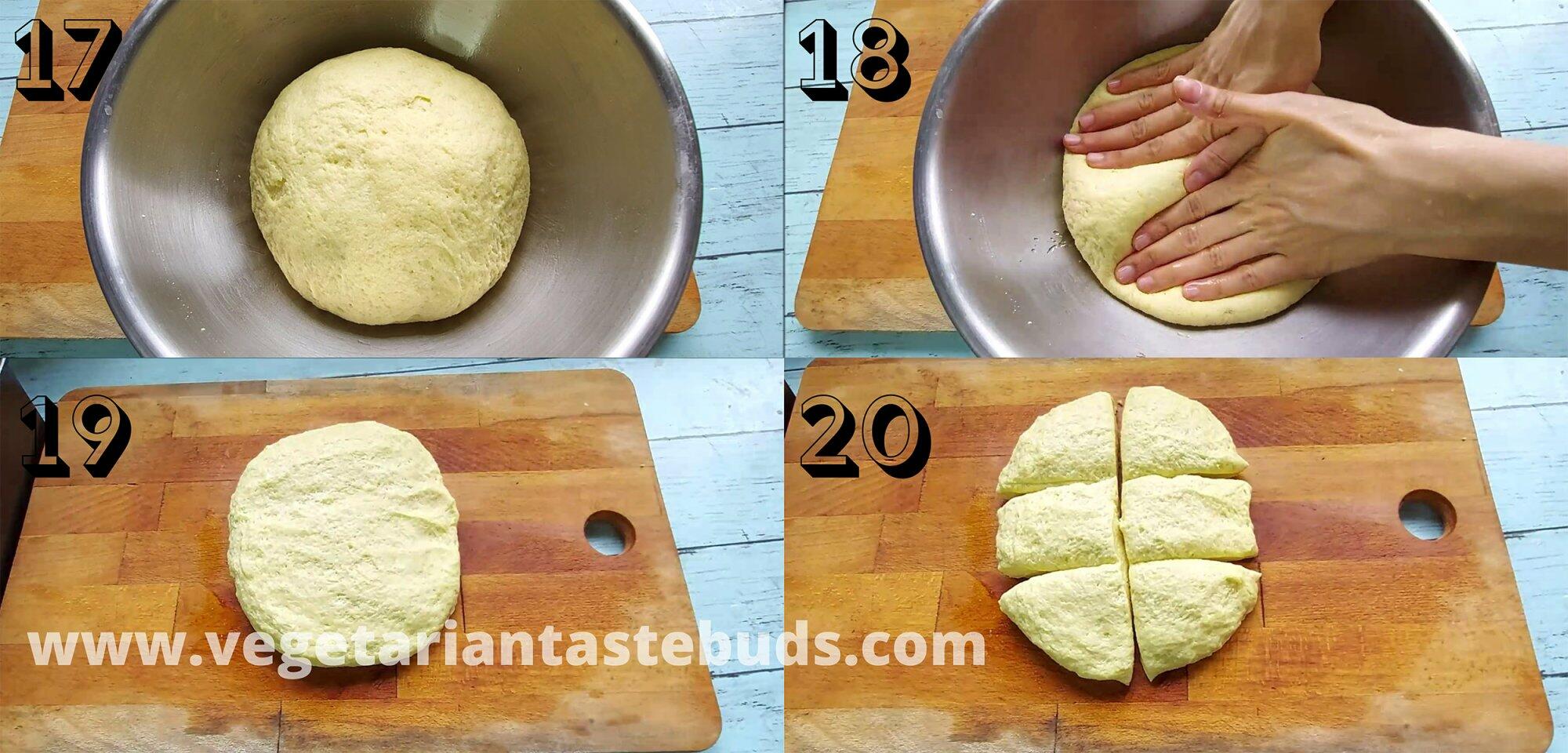
- Take one portion in your palm and with other hand bring all the edges together and lightly pinch. Now roll ball in circular motion to make a round shape. Do this for all 6 pavs. Make sure there are no cracks in the balls that you form.
- Place the pavs into greased baking tin, leave little gap but not too much. Cover and let it proof for another 40 minutes.

- Pre-heat oven to 200 degrees Celsius for 10 minutes.
- After 40 minutes, brush the top of pav with milk and bake in preheated oven at 200 degrees Celsius for 15 minutes or until the top turns light brown. If you feel top is not brown enough after 12 minutes, you may brush pav with oil and bake for 2-3 mins more.
- Once baked, take it out of oven immediately. Top part will be slightly hard. Immediately apply butter on top. Once you apply butter, wait for 5 minutes so butter is absorbed. Then cover and keep for another 5 minutes.
- Then invert and keep on a wire rack. When you will invert, the bottom part will be slightly soft, but it will be ok once it cools down completely.
- Again cover and let it cool down completely on the wire rack for atleast for 1-2 hours before storing in container.
- Once the pav cools down completely, then separate them. Enjoy.
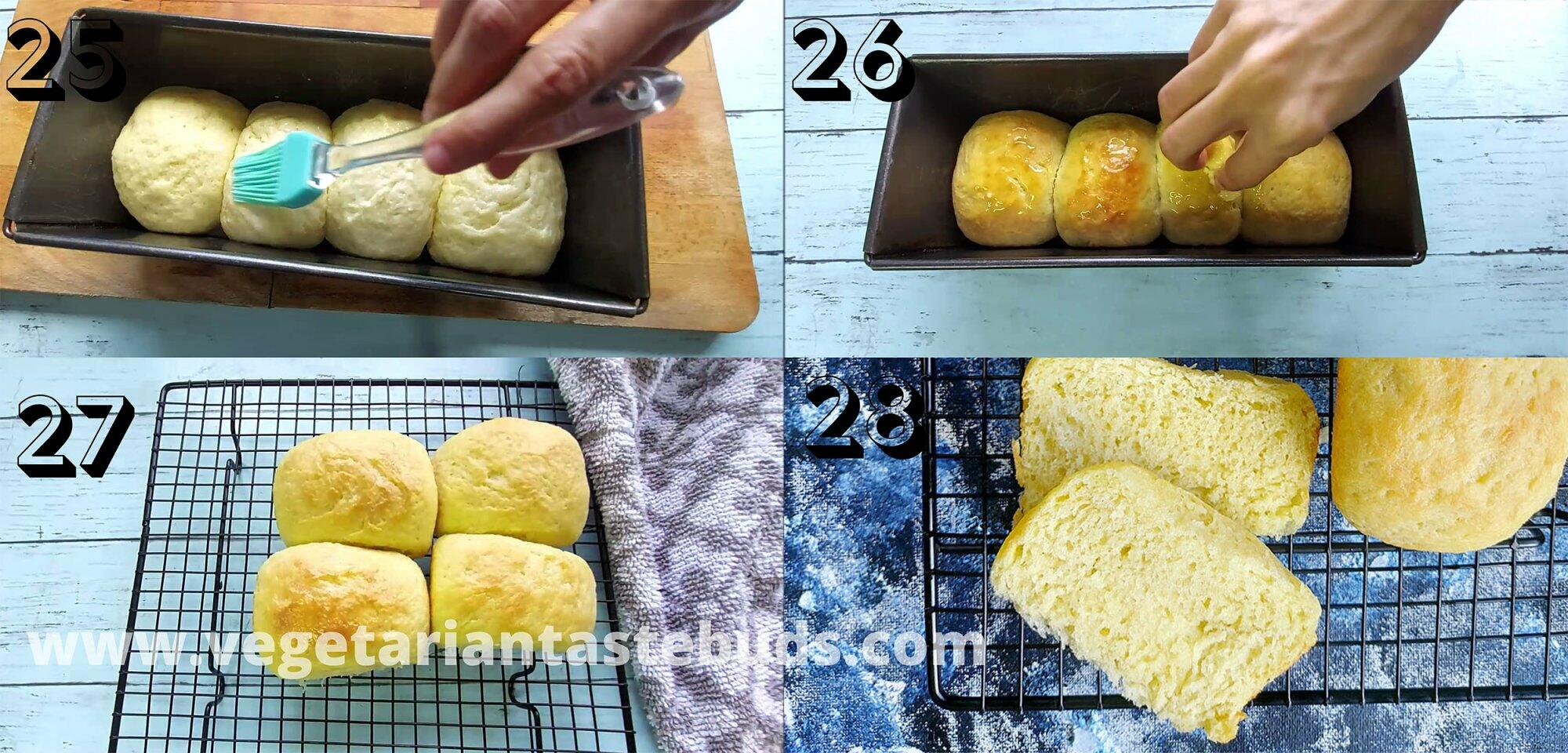
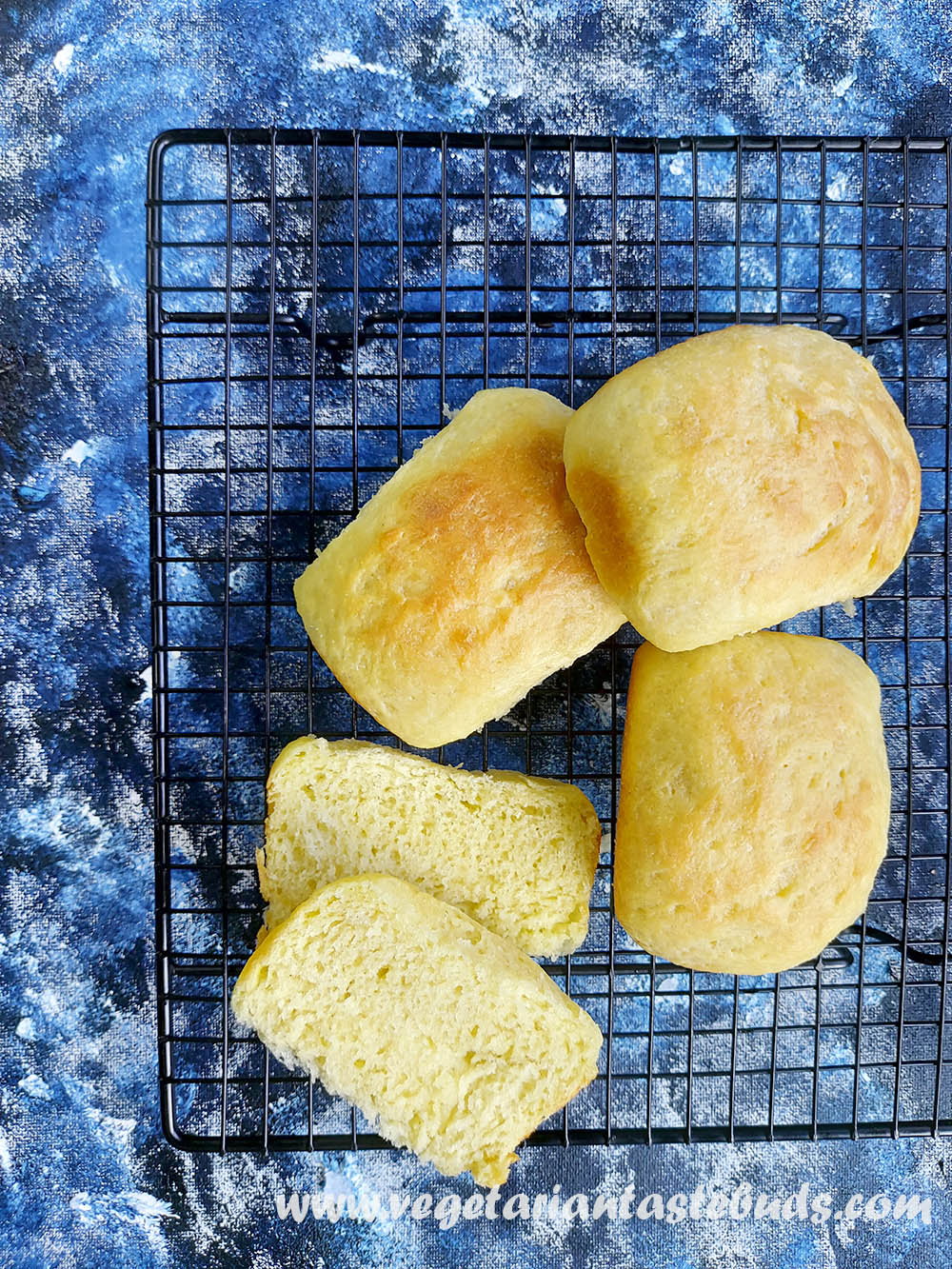
Also, do have a look at other Bread Recipes on the blog :
Eggless Herbed Focaccia Bread Recipe
Eggless Tutti Fruity Sweet Buns
10 tips to make perfect bread + failproof sandwich bread recipe
Recipe Card

Sooji Ladi Pav Recipe | eggless semolina (suji/rava) buns recipe
Loved this recipe? Leave a comment below and give us a 5★ rating
Ingredients (1 cup = 240 ml)
For yeast fermentation
- ¼ cup lukewarm water
- ¾ teaspoon instant dry yeast refer notes section for conversion to active dry yeast
- 2 teaspoon sugar
For the dough
- 1.5 cups semolina flour/fine sooji/chiroti rava or 260 grams
- 1.5 tablespoon milk powder (unsweetened)
- ½ teaspoon salt
- 2 tablespoon odourless oil
- ¼ - ½ cup lukewarm water (adjust as required)
- extra oil for kneading, coating dough
Instructions
For yeast fermentation
- In a small bowl, combine ¼ cup warm water, yeast and sugar. Water should not be too hot, it should be just warm. To test, dip your finger in it, if you are comfortable then temperature is ok. If you feel it is hot then let it cool down a bit.
- Stir well till no lumps remain. If you see that there are lumps of yeast in the mixture, heat the mixture for a few seconds. Cover and set aside for about 10 minutes or till the mixture is frothy. If the mixture does not turn frothy, discard this and start again.
For the dough
- In a big wide bowl, combine semolina flour (fine sooji) and milk powder.
- Now add frothy yeast mixture and mix. Gradually add warm water and combine everything together. You will need about ¼ cup water at this stage. Sooji will absorb water while kneading, so you can add remaining quantity of water at that stage.
- Once everything is combined well, add 1 tablespoon oil and knead till oil is absorbed into the dough.
- Now take this dough on a flat surface and knead well for a total of 12-15 minutes. After about 5 minutes of kneading, start adding 1 tablespoon oil gradually and keep kneading. Along with oil you can also sprinkle water while kneading. As we mentioned earlier, sooji will absorb excess water and dough will turn dry while kneading. So you have you keep adding oil & water while kneading dough. Knead until you get a smooth dough. Dough prepared from semolina will take a bit more time as compared to maida/wheat flour dough.
- How to know when the dough is ready :Knead the dough for 12-15 minutes, but do not over-knead. Once ready, dough will become elastic - you will be able to easily stretch the dough, it will pass the window pane test and dough will not stick to the surface in which you are kneading the dough.
- Now at this stage we will add salt. Spread the dough and add salt and sprinkle few drops of oil/water over it and mix. Now knead the dough for 2-3 minutes till salt is mixed well with the dough.
- Once you are done with kneading, wash your hands so the dough doesn’t stick more. Texture of the dough should be smooth and not sticky. Then put few drops of oil on the dough and shape the dough into a smooth ball. Take a bowl, grease it with some oil and place the dough in the bowl. Coat dough with oil, cover the dough with a kitchen towel or plate. Keep aside to rise for 1 - 1.5 hours or till dough doubles in size.
- Grease baking tin with generous amount of oil. This much quantity of ingredients will yield 6 pav buns. These buns will be of the size that you usually get in market for vada pav or pav bhaji. If you prefer small size buns, then you can make 7-8 pavs. We have used 9 inch bread tin to make 4 pav and remaining 2 pavs we have prepared in muffin moulds.
- Once the dough doubles in size, punch the dough and knead lightly for about a minute. Spread oil on a flat surface and place dough over it. Flatten the dough with your fingers and shape it rectangular. With the help of a sharp knife or pizza cutter, divide into 6 equal portions.
- Take one portion in your palm and with other hand bring all the edges together and lightly pinch. Now roll ball in circular motion to make a round shape. Do this for all 6 pavs. Make sure there are no cracks in the balls that you form.
- Place the pavs into greased baking tin, leave little gap but not too much. Cover and let it proof for another 40 minutes.
- Pre-heat oven to 200 degrees Celsius for 10 minutes.
- After 40 minutes, brush the top of pav with milk and bake in preheated oven at 200 degrees Celsius for 15 minutes or until the top turns light brown. If you feel top is not brown enough after 12 minutes, you may brush pav with oil and bake for 2-3 mins more.
- Once baked, take it out of oven immediately. Top part will be slightly hard. Immediately apply butter on top. Once you apply butter, wait for 5 minutes so butter is absorbed. Then cover and keep for another 5 minutes.
- Then invert and keep on a wire rack. When you will invert, the bottom part will be slightly soft, but it will be ok once it cools down completely.
- Again cover and let it cool down completely on the wire rack for atleast for 1-2 hours before storing in container. Once the pav cools down completely, then separate them. Enjoy.
Video
Notes
- Use raw sooji/rava. Do not use roasted suji.
- You can use the same recipe for making Semolina Sandwich Bread.
- Gradually add warm water while kneading the dough. You will need about ¼ cup water at this stage. Sooji will absorb water while kneading, so you can add remaining quantity of water at that stage.
Nutrition
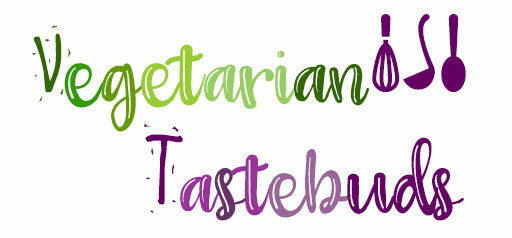

Leave a Reply